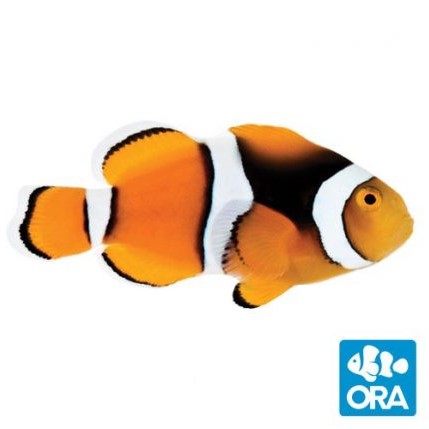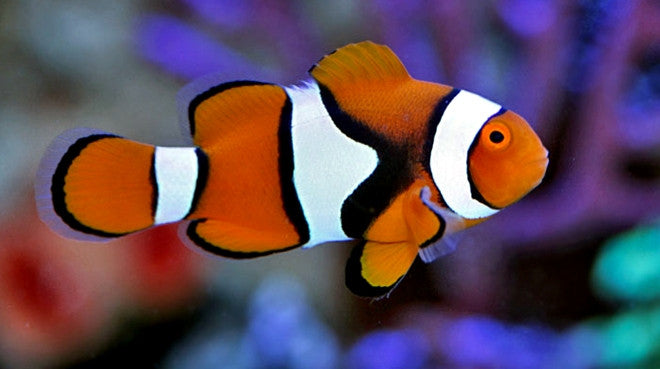Year End Clearance Sale 50% Off All Corals
Free Shipping Over $249 or $29.99 for Orders over $100
ORA Percula Clownfish - Captive Bred
$ 29.99
Please select all options.
How to Care for Percula Clownfish
written by Dave Burr
Behavior: The Percula Clownfish is often confused with the Ocellaris Clownfish which has a similar orange and white color scheme. The easiest way to tell them apart is to remember that the Percula Clownfish has thick bands of black between his white stripes while the Ocellaris Clownfish has only a thin black line along the edge of its stripes.
As with most clownfish, the Percula Clownfish is best kept singly unless a pair is introduced together. It may attack other clownfishes and nip at passive tank-mates who wander near its host anemone or territory. Generally, it is a great fish for the reef aquarium and spends much of its time nestled peacefully in its anemone. If you plan to keep other clownfish, it is best to do it in a larger aquarium of 100 gallons or more and provide each clownfish, or pair of clownfish, with their own anemone. That way each fish has a comfortable home and quarrels will be reduced. Adding all of the clownfish at the same time will also help to reduce territorial disputes.
Symbiotic Relationship: The Percula Clownfish does not require a host anemone for survival; however it is a real treat for any hobbyist to observe the symbiotic relationship between the clownfish and its host anemone. The anemone provides a safe haven for the clownfish because its tentacles will inflict a painful sting on all but other clownfish. The clownfish, in return, chases off fish that threaten to pick at the anemone and brings it scraps of food. The Percula Clownfish prefers the Long Tentacle Anemone, Rose Bubble Tip Anemone, or Bubble Tip Anemone.
Feeding: Offer the Percula Clownfish mysis shrimp and frozen herbivore preparations 4-5 times per week. Their diet consists mostly of meaty foods, however they will accept some algae based foods as well. Soaking all fish food with vitamins will help keep your fish healthier and make them less susceptible to disease. We recommend soaking food in garlic as well when adding new fish and whenever your notice ich or other disease in the aquarium. Garlic will help repel external parasites and will boost the fishes immunity.
Feeding Tips: Remember to feed slowly. Leftover food will cause nitrates and phosphates to rise. If you see food falling to the sand bed and into the rocks, you should feed slower and give the fish a chance to eat before adding a little more. Using a turkey baster allows you to target food to different fish. For example you can feed the aggressive fish on one side of the tank and then squirt a little bit on the other side for the less aggressive fish. This way all the fish get a chance to eat enough.
Maximum Length: 3"
Care Level: Easy
Family: Pomacentridae
Reef Compatibility: Excellent
Minimum Aquarium Size: 30 gal.
Range: Indo Pacific, Australia, Solomon Islands
Diet: Omnivore
Water Conditions: 75-80° F; sg 1.024-1.026 (1.025 is ideal); pH 8.1-8.4 Ca 420-440 ppm, Alk 8-9.5 dKH, Mg 1260-1350, Nitrates <10ppm, Phosphates, < .10ppm
Water Chemistry: Maintaining Ammonia at 0 ppm, Nitrites at 0 ppm, and Nitrates below 10ppm will help to keep your Percula Clownfish happy and healthy. We recommend doing a water change soon after Nitrates rise above 10 ppm. Maintaining proper calcium (420-440 ppm), alkalinity (8-9.5 dkh - run it 7-8 if you are carbon dosing) , and magnesium levels (1260-1350 ppm) will help to keep pH stable in the 8.1-8.4 range. We recommend a specific gravity of 1.024-1.026 with 1.025 being ideal for fish. Temperature should remain stable as well and should stay within a 2 degree range.
Video
Category: 25-50, amphiprion-percula, Clownfish, easy, omnivore, ORA Farms, pairs, reef-compatible, symbiotic-relationships
Type: Saltwater Fish



